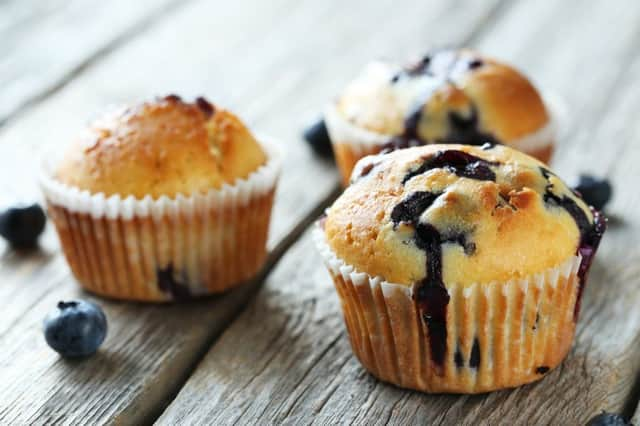Muffins found to have '˜more sugar than can of Coke'


On average, muffins bought on-the-go at railway station food outlets had 19 per cent more sugar per portion and were almost a third bigger than those bought in supermarkets. Meanwhile, 61 per cent of all the muffins included in the survey contained six teaspoons of sugar or more, which is the upper daily limit for a child aged seven to ten years old.
McDonald’s blueberry muffins and Pret A Manger double berry muffins both have eight teaspoons in a typical portion. This compares to three teaspoons each in M&S blueberry muffins and four teaspoons per muffin in Co-op Bakery blueberry muffins. The Pret a Manger muffin was also the largest portion size of those surveyed, at 124g – almost twice the 64g on offer at the Co-op. A can of Coke typically contains around seven teaspoons of sugar.
Advertisement
Hide AdAdvertisement
Hide AdIt is recommended that children aged four to six years have no more than the equivalent of five teaspoons of sugar per day, no more than six teaspoons for those aged seven to ten and no more than seven for those aged 11 years and upwards. Adults are also advised not to consume more than the equivalent of seven teaspoons a day – less than the amount found in a Costa blueberry muffin.
Caroline Cerny, Obesity Health Alliance lead, said: “We may think grabbing a blueberry muffin is a reasonably healthy option for a snack on the go compared to other cakes or a chocolate bar – yet the figures suggest otherwise. There is huge variation in both the size of muffins and the sugar content, and with limited nutrition labelling it’s all too easy to eat a huge amount of sugar in just one serving.
“Some of the muffins on sale have twice as much sugar than others. This shows that it is possible for industry to significantly reduce sugar even in their most sugary products to help us all make healthier choices. Industry must step up to the plate and take responsibility for making the food they produce healthier.”
The two groups are calling for manufacturers to reduce sugar in line with the UK government’s plans to cut sugar in common products by 20 per cent by 2020. They also want all “out of home outlets” such as cafes and supermarkets to be transparent about the nutrition content of products by making “traffic light” nutrition labelling available to consumers at the point of sale.
The report also found that there is also lack of nutrition labelling on products sold at popular outlets in train stations such as AMT Coffee, Delice de France, Patisserie Valerie, Pumpkin, Ritazza and Upper Crust and in supermarket bakeries, meaning consumers are in the dark about exactly what they are eating.
Nutritionist Kawther Hashem, from Action on Sugar, said: “During the Easter holidays, if families are travelling through these busy stations and buy blueberry muffins from one of the outlets available, those kids would likely be consuming almost their entire recommended limit of sugar that day, if not more. And worryingly, it’s very difficult to know exactly what’s in these products as there is often no clear nutrition information at the point of sale.”